Mongolian gerbils (Meriones unguiculatus) and fancy rats (Rattus norvegicus) are two of the most common small animals people choose as a first pet – but there are quite big differences between them with regards to how they live and what they love.
This quick comparison guide should help you understand these differences and give you an insight into their care if you do chose them as pets in the future
Mongolian Gerbils – Typical Lifespan: 2.5 years to 4 years
Fancy Rats – Typical Lifespan: 2 to 3 years
Now let’s get down to the real details…
Shape & Size:
Gerbils stand tall and and quite slender – spending a lot of their time sitting on their strong back legs like mini wallabies – their long fluffy tail helping them to balance – fancy rats however could more be described as low and wide.
Fancy rats tend to use all of their legs to do everything really including climbing, dangling and bouncing. They also have a long tail like gerbils – but a fancy rats tail is longer, hairless and prehensile – meaning it can move on its own and curl around things – like an extra hand or foot.
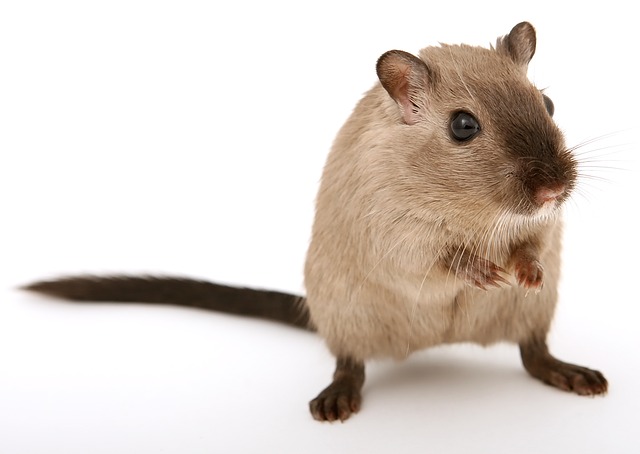
Both can be carried around by young people very easily, however fancy rats, tend to want to sit on your shoulders and heads rather than in your hands (well, you can’t stop them trying really). Fancy rats (350g to 650g – (1-2lb)) are considerably larger than gerbils (between 60g – 100g on average) and are much more clingy.
Fancy rats can come in a wider variety of colours and markings (different patterns of white hairs like hooded, Berkshire and capped) than gerbils – but many are the same genes but with different names (silver fawn instead of argente; and apricot instead of dilute argente).
Fancy rats also have larger choice of coat types including Naked and Harley coats which are very common in the fancy. They also can have ‘dumbo’ ears where the ears are set low on the head – a feature not found in gerbils.
Gerbils can have a Rex or Wavy coat similar to fancy rats – but these are quite new to the Gerbil Fancy and so not so widespread – however, gerbils can be Nutmeg or Honey in colour – whereas this gene has yet to be found in fancy rats.
Family & Friends:
Fancy rats LOVE friends and can easily live together in groups or 4 or more – and the groups can change size quite easily without too much upset.
Whether they are male or female – whether they are related or not – or whether they have been apart for days – fancy rats just make friends again. It is all through social hierarchy though so there can be some squabbles here and there – but usually everything settles down with nothing more than a few scratches.
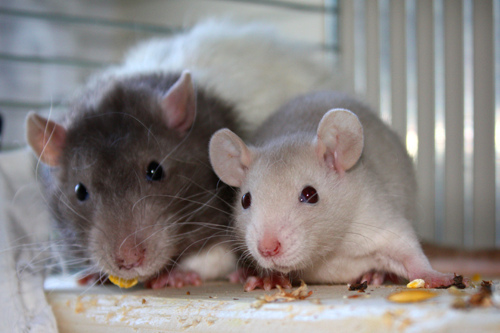

Gerbils thrive on company too as they are very sociable rodents and in nature would choose to live in extended family clans – but they are very fussy about their groups – and the groups can’t chop and change about like they can with fancy rats.
Gerbil clans – once established – need to remain very stable. You can’t go taking out gerbils or adding new ones into the clan – it just won’t work. Adult female gerbils can be unstable enough once they know each other in an established clan or three or more – even if related – so you can never mix random groups of females together.
Males are more accepting but even adding a single male pup to an adult male pair can spell disaster.
Gerbils really don’t like strangers or other existing clans – so unlike fancy rats – they can’t just be put together to work it out themselves – unfortunately there can be really serious injuries. Don’t worry though if you have a single gerbil – they can still make friends (single gerbils are the best at making friends – but it still needs to be controlled in a split introduction (see Split Tank Introductions – What is a Split Tank?)
Using the widely recommended split tank introduction procedure to mix up their scents, you can easily introduce two single gerbils to each other over a short period of time and they will form a new clan.
Character & Cuddles:
Gerbils are very inquisitive at all times of day – they aren’t generally nocturnal or creatures of habit so putting anything new into their tank at any time will no doubt wake them up and start some activity. Fancy rats are the same, however, they might only look out at you from their cosy hammock and see whether it is worth getting up for.
Fancy rats are really friendly for cuddles and if left to their own devices, will wake and sleep throughout the day just like gerbils.
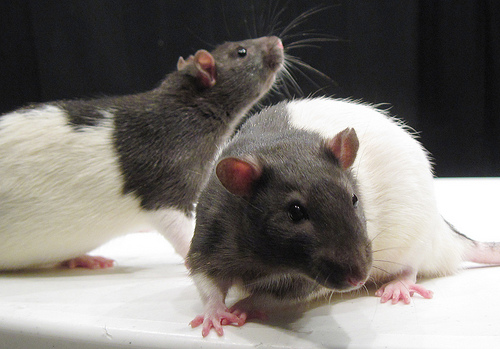

Both gerbils and fancy rats often come looking for attention and cuddles at any time of day and often get in the habit of coming out to see you regularly – such as when you first get home.
Both can respond to their names being called (or just any noise that is the same and associated with treats – but we don’t tell ourselves that) but you can find fancy rats to be more demanding to coming out time – whereas most gerbils are quite content to do some more digging…
Both gerbils and fancy rats are easy to hand tame – and both can be taught to perform tricks using the clicker training method (you don’t actually need a clicker).
Home & Housing:
This is where gerbils and fancy rats are quite different. Due to their very different natural features and lifestyles, they both require very different things out of their homes and habitats.
Gerbils really need to live in a glass tank (with or without a cage as a topper) where as fancy rats don’t so well in a tank at all (it can cause terrible health issues). Fancy rats need a barred, un-galvanised, well-ventilated cage set-up (with no rust or white patches) – ideally with plenty of height and width for climbing – and to cater for their large group numbers.
Gerbils love to tunnel, dig and chew – and as a result they need to be housed in an emclosure that is deep enough for a good few inches of substrate for digging in as well as having space under that substrate for tunnels (man-made purchases) and tunnelling (they will dig their own).
They also need to be in a home that doesn’t have any weak points that they can chew through (bearing in mind they can chew through solid wood if they set their mind to it) or anything in or around their tank made of plastic. Gerbils can chew through plastic vents, plastic stoppers and plastic tunnels in less than half an hour – and if that plastic is the only thing between your gerbil and the outside world – you are going to have a lost gerbil at any point…
Fancy rats, however, don’t really chew anything and can have the same lovely green hammock bed for their entire life.
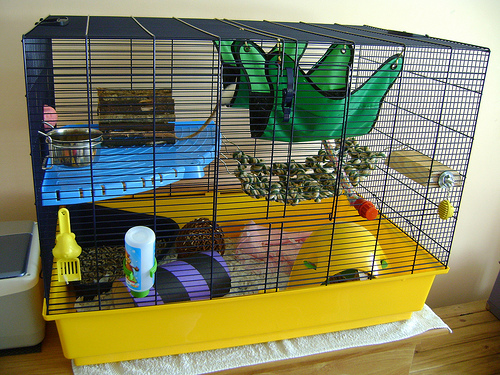

Rats love climbing and need ventilation and space for friends – so there are quite a few larger cages that they can live quite happily in.
They don’t do well on wood shavings or other dusty bedding (they are better with pelleted bedding or fleece) as they don’t really spend a lot of time on the bottom of their cage anyway. The perfect fancy rat cage has plenty of layers of hanging fleece, hidey-holes and hammocks instead.
They can still chew plastic if they want, and can escape from badly constructed cages – but scarily – they can even figure out how to unlock simple cage catches – so you need to look for a strong, secure cage for these mischievous little things…
Gerbils could never unlock a sliding bolt or spring clip as their hands (and brains) aren’t designed like that – but rats are very dexterous and agile – so beware.
Spending more on a suitable cage (rather than trying to adapt an unsuitable cage) is worth every penny.
Smell & Scent-Marking
Fancy rats have got an odor – a general smell that stays with them at all times and can’t be got rid of even if you super-scrub their whole cage every day. It isn’t unpleasant to those who love rats – but you will get comments about it from others all the time.
Fancy rats also poo and pee a lot – and all over the place – so if you have any areas of bare metal or plastic – this will need cleaning up virtually every day. They can’t be fully toilet trained really – so although most of it will end up in the litter tray – the rest just comes out whenever – same as gerbils – however, fancy rat homes can look pretty grim after 4 or 5 of them have been pooping all day.
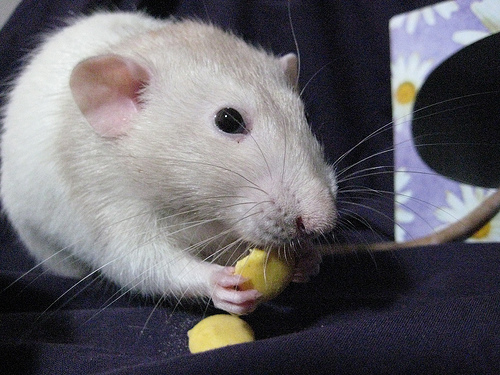

Smell-wise: gerbils have a special gland in the middle of their tummies for scent-marking – so they don’t do it with liquids of solids like other rodents do – therefore gerbils are one of the least ‘smelly’ pets for keeping indoors.
Gerbils have no overall odor in their coats either and glass doesn’t retain or enhance smells, so unless the bedding has been in the tank too long; the water bottle has leaked; or fresh food has spoiled, it won’t smell too bad. Infact most large gerbil tanks only need cleaning out once every month or so as there is so much substrate in there absorbing the smell and any waste.
Basically, your healthy gerbils won’t smell.
Foods & Feeding:
Gerbil and fancy rat commercial diets contain roughly the same foods – if you look at the actual ingredients on foods such as Gerri Gerbil compared to Reggie Rat to compare – and neither have really special dietary requirements (other than avoiding unsafe foods).
They both do well on a commercially-made foods – either the muesli type (the fun type: where you can see all the individual ingredients) or an extruded type (the pelleted type: where all the ingredients are mashed together and you can’t see what the individual parts are).
Some rat breeders like to use a specific pelleted extruded food or use lab blocks which give better overall nutrition than the muesli types as they eliminate selective feeding. Others like to make their own food as they have specific health issues to take into consideration.
Fancy rats are very prone to tumours, and some people think that diet is the key to preventing the incidence of this – some even saying that they can double the lifespan of fancy rats by tailoring the diet?
Normal adult gerbils do well on the following levels of protein, fats and fibre (12%, 6-8% and 4-6%) which are found in most store-bought products – as well as a sprinkling of fresh fruit and vegetables a few times a week from a species-relevant fresh food safe list.
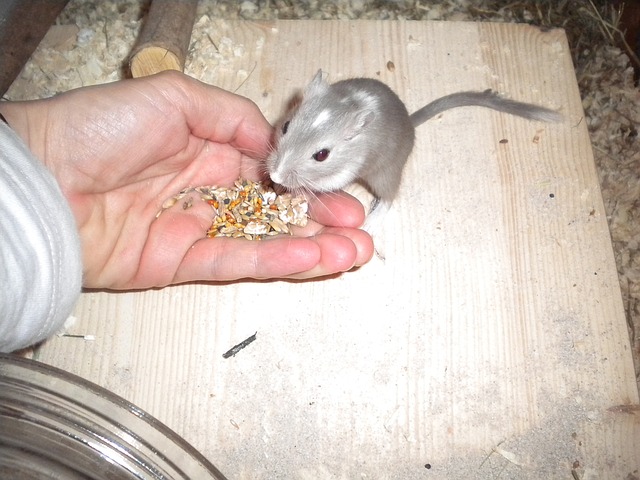
However, rat foods vary hugely in macro-nutrient levels and some are vegetarian and others are much higher in meat content. Protein varies between 14-20%, fats from 3-5% and fibre from 4-8% – so it isn’t overly clear what anyone should recommend.
Both also like a small amount of live food/dried live food including mealworms and waxworms etc – both eating such things in nature as part of their everyday lives as well as fresh plants and wood to chew on (gerbils more so as they just love to chew things to pieces!).
Healthy adult gerbils and fancy rats on a complete food do not need vitamin or mineral supplements in their water or as mineral stones, but there is no harm in offering them at all – although with gerbils, you might regret it at 2am though when they start kicking it against the side of their tank!
Saying this though, sick, older, pregnant or lactating fancy rats and gerbils could well benefit from these and other extra nutrients.
Age & Illness:
Both gerbils and fancy rats are short-lived compared to other larger pets like dogs and rabbits – but this doesn’t mean that they can’t have substantial lives.
Gerbils are deemed adult at around 12 weeks of age and can often live to 4 years or over – with 3 years being very common these days. Gerbils can pass at any age of course, but this is usually due to accidents and internal genetics rather than potential lifespan.
However, many a gerbil life is cut short from several common illnesses which usually strike from 2 years onward – and these include: Scent Gland Tumours – found mainly in males and restricted to the scent gland only (which can be surgically removed in any healthy gerbil); Ovarian Cysts – found only in females only and cause her to swell out sideways (and which can be surgically drained in healthy younger females); and Strokes which can affect any gerbils at any age and can’t be treated or prevented by veterinary intervention – just palliative care during and afterwards.
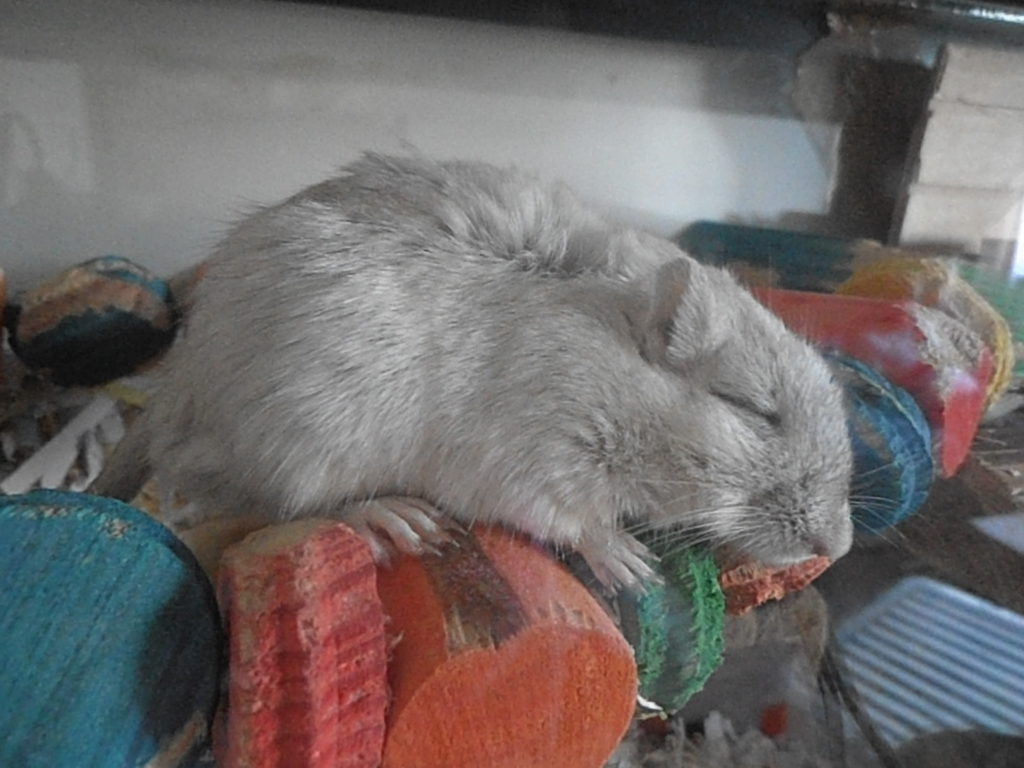
Fancy rats are deemed adult at around 12/13 weeks of age and can often live to 3 or older with a specific diet – but with 2 years being the most common for those on regular foods.
Most common age-related illnesses in fancy rats include but aren’t restricted to: fast-growing Tumours – fancy rats are so prone to tumours, that it has become their ‘thing’ almost. Surgery is always an option – but the tumours often come back quickly – or you grow three more elsewhere; Respiratory Infections – are also quite common in fancy rats who are very sensitive to dusts and odors – so choosing a substrate and keeping them clean is paramount.
As fancy rats are quite relaxed about their groups – their illnesses don’t adversely affect their friends and family – but a sick gerbil can have some obvious effects on a gerbil clan.
If the leader of a gerbil clan becomes really ill, it can cause one of the other gerbils to stand up and take their place – very normal in gerbil worlds – but this means they will sometimes chase or even attack the sick gerbil (gerbil language for “you are too weak – please leave”).
Also, (unfortunately) it is quite normal in the gerbil world to start to eat your dead friend – so don’t be offended by your gerbils doing this – or assume that they killed their tank mate in the first place and then did this. They didn’t – they were just tidying up.
Breeding & Babies:
This is another area where gerbils and fancy rats differ considerably – although both are great mothers and have very few birthing issues.
Fancy rats are communal living and very adaptable to new situations – as we have already said – why would it be any different when it comes to mating? A female fancy rat will come into heat every 4-5 days – and then she will mate if a male turns up on the scene.
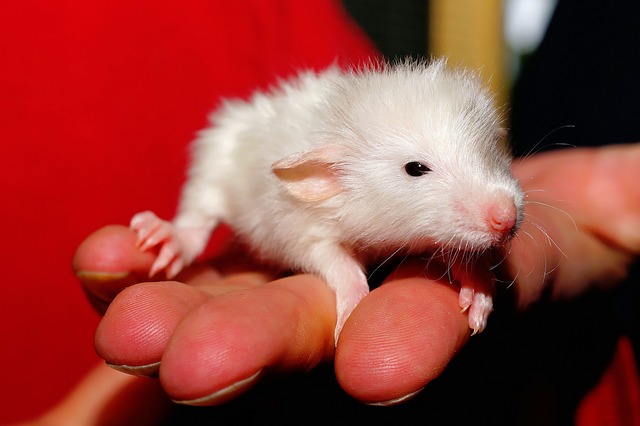
She doesn’t mind whether she has been living with him for several weeks or whether she just gets put into a small cage with a complete stranger for the first time – she will mate with him with very little fuss or aggression.
Regardless of whether they were together for half an hour or 3 weeks, the male won’t play any part of raising his children. As fancy rats come into heat they day they give birth (just like gerbils), if they are weaning the first litter AND are pregnant the second pups do not do so well at all. Best avoided completely.
After around 22 days the litter is born with (on average between 8-12 pups) which she can rasie perfectly well with the right diet – and the female raises the young on her own quite happily (or with her female friends). She won’t have another litter until they are all weaned and homed at around 4-6 weeks of age and she is in heat and meets another male…
However, with gerbils we are looking at long term love and a working partnership.
A male and female gerbil can become friends even if she is not in heat (which usually happens every 4 or so days) and they will live together as besties this whole time. At some point they will mate – which takes about 3-4 hours and involves a lot or running around, chasing and thrusting and then they just carry back on as normal – you don’t take the male out after mating as he will be helping to raise the first litter of pups (usually between 3-6 pups).
I say first, as gerbils are set up to have two litters in a row, they mate on the very same day they give birth to the first litter – often ignoring the newly-born pups for several hours after birth – all quite normal.
So if you find an accidental litter of pups in your tank – there is no point taking the male out immediately – the female is already pregnant anyway – so he can’t do any more damage – infact he can really help her out for several weeks.
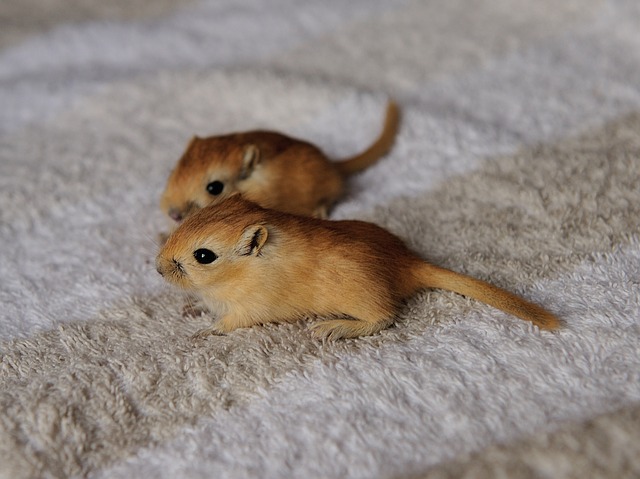
So having said that, the male gerbil always helps mum to raise the first litter (gerbils males make great dads) and after around 24 to 36 days – the female will have the second litter (usually around 4-7 pups – so an average of 7-10 pups total).
Obviously, you need to take out the original male BEFORE this second litter unless you want a third litter (but which the female gerbil certainly doesn’t), and you can take him out with all of his sons from the first litter who are weaned by now (pups are fully weaned at around 4 weeks) and put them in a separate tank. One or more of the first litter daughters will help mum raise the second litter.
Extras & Exceptions:
Gerbils usually have a sand bath to keep them clean (any uncalcified plain child-friendly sand) – as it helps with the oils in their coats. You can also use the same dust/sand as for chinchillas or you can use corn flour for this. They will pee and poo in this as well as eat it? Rats will not enjoy anything of the sort…
Fancy rats can eat most foods that humans eat (do check the non-safe food list though) – whereas a gerbil safe food listing is much more restricted – so if you like feeding your pets mini roast dinners, mashed potato and oysters – you need to go for fancy rats!
Gerbils really do not like to swim or really even just getting wet – so please don’t make them – but fancy rats love to dabble in cool shallow water when they are hot – especially if there is food involved. There is many a video online of rats fishing for peas with their little front feet…
Gerbils can use solid plastic wheels for exercise – but not if it means less bedding for digging. Not all gerbils use them – but you can usually suspend them from the top of the tank or add a tank topper for the wheel for added entertainment. The wheel would ideally be 8” or more in diameter and solid plastic (rather than bars of any kind). Same with fancy rats – no bars – but theirs would need to be larger than 12” – and they might not use it anyway?
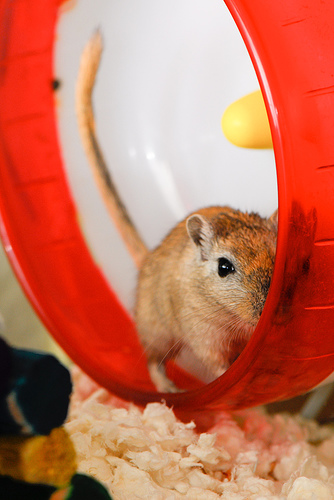

Hopefully, all this information has helped you decide on a few things with regards to Gerbils Vs Rats?
If not – do look at some of our other Vs articles to help you look at all the options before deciding on your new pet or pets…
Thanks for all the information! This was very detailed and helpful! Now that I’ve done my research, I will present everything to my daughter, with pictures, and find out if we will be adopting two fancy rats or two gerbils.
I love it when someone does their reserch first before just pointing at a new pet in a store – and thank you for visiting us as one of your sources of information. I hope were covered all the basics?
If you have any more questions, do just ask away as each of these pets has their own foibles that can influence your choice.
Anyway, I hope you have fun with your new pets – whichever you and your daughter choose – and now it’s just onto the difficult task of choosing some names…
RodentZone
You say that rats can not be trained to use a litter tray and that they pee all over the place, not true. Place a tray of pelleted kitty litter with a smooth stone it it, and they will go in the tray, sit on the stone and poop and pee.
Thanks for your comments Angela and I have made a change to the article as a result of your comments.
I have never really had great luck myself with toilet training my rats, and although I do supply them with a litter tray, they only use it for a small percentage of their actions – and they continued to wee on the shelf as often as they could. I find the same with my gerbils – they will poop and pee in their sand bath, but I would never say they are totally toilet trained for sure.
I have spoken to a few more of my ratty friends and they have said that some of their rats seem to use to toilet more for poops – and some are VERY good at it – but the pee on the shelves can become a daily task.
Thanks for your imput though – I am always glad to find out more about other people’s experiences. Especially about the stone.
Perhaps I need to get me some more rats so I can try the stone? It’s been a while…
RodentZone.